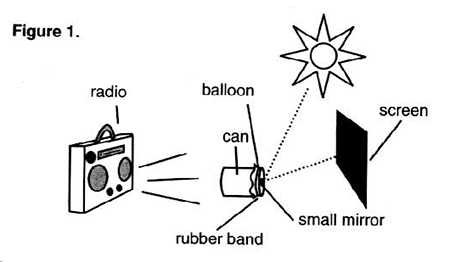Bursts of Energy...
Seeing Sound
Recommended grade levels: K-6
Goal:Students will use a model to assist them in visualizing a sound wave.
Process skills:
- Applying concepts
- Collecting data
- Communicating
- Controlling variables
- Making graphs
- Observing
Predicting
Frameworks: Matter
Materials:(per student group)
- Making graphs
- Observing
- Predicting
one coffee can.
- oatmeal container or other metal can
- can opener
- scissors
- one large balloon
- one small mirror ( 1-2 cm in diameter)
- one rubber band
- glue
- one small radio
- dark surface (screen) for reflected light (black construction paper works)
Teacher background information:
Sounds are longitudinal waves of compressed air moving outward from a vibrating sound. It is
the back-and-forth motion of the source that creates the sound.
 One of the interesting features of sound (or any other kind of wave) is that, while a sound wave
may move long distances, the material it is moving through hardly moves at all. Thus, a sound
wave can travel from one side of the room to the other, but the air molecules in the room remain
in the place they started.
When the wave is actually moving past a given air molecule the
molecule will move back-and-forth, passing on the wave's energy to its nearest neighbor, and
then settle back into its original position. The greater the volume, the larger the molecule's
motion, and the more energy the sound carries.
One of the interesting features of sound (or any other kind of wave) is that, while a sound wave
may move long distances, the material it is moving through hardly moves at all. Thus, a sound
wave can travel from one side of the room to the other, but the air molecules in the room remain
in the place they started.
When the wave is actually moving past a given air molecule the
molecule will move back-and-forth, passing on the wave's energy to its nearest neighbor, and
then settle back into its original position. The greater the volume, the larger the molecule's
motion, and the more energy the sound carries.
Procedure:
Student groups will:
-
Discuss sound as a form of energy prior to the activity.
- List examples of sounds at home,
at school, and in the community and rank them in terms of increasing volume.
Remove both ends of the coffee or oatmeal container.
- Cut a piece of the balloon large
enough to stretch tightly over one end of the container and secure it with a rubber band.
- Glue the mirror onto the outside of the balloon, slightly off center.
- Hold the open end of the container up to the radio.
- Position the minor so that a spot of
sun (or a flashlight beam) reflects from the mirror onto a dark surface. (See Figure 1.)
- Predict what will happen when the radio is turned on.
- Turn the radio on and slowly turn the volume up.
- Observe the light and record
observations.
Discussion:
- What happened to the spot as you increased the volume?
- Why do you think this happened'!
Extensions:
Have students:
- Experiment with different sized cans, cardboard cylinders or paper cups.
- Construct a musical instrument using a variety of common materials.
- Demonstrate sound with the musical instrument.
- Donate instruments to a primary classroom.
- Do the activity with a primary classroom that is studying sound energy.
Teacher resources:
Kaner, Etta. Sound Science
Gr. 2-5. This book explores the nature of sound through 40+ experiments, riddles, interesting facts, puzzles, and games.
ISDN: 0-201-56758-X
Lafferty, Peter. Light and Sound
Gr. 4-8. This book explains sound as being similar to light in that both travel in waves and can be reflected and refracted. The "It's Amazing" insert provides interesting facts for students to ponder. A chronological time line of inventions and discoveries is included.
ISBN: 0-7614-0030-3
 One of the interesting features of sound (or any other kind of wave) is that, while a sound wave
may move long distances, the material it is moving through hardly moves at all. Thus, a sound
wave can travel from one side of the room to the other, but the air molecules in the room remain
in the place they started.
When the wave is actually moving past a given air molecule the
molecule will move back-and-forth, passing on the wave's energy to its nearest neighbor, and
then settle back into its original position. The greater the volume, the larger the molecule's
motion, and the more energy the sound carries.
One of the interesting features of sound (or any other kind of wave) is that, while a sound wave
may move long distances, the material it is moving through hardly moves at all. Thus, a sound
wave can travel from one side of the room to the other, but the air molecules in the room remain
in the place they started.
When the wave is actually moving past a given air molecule the
molecule will move back-and-forth, passing on the wave's energy to its nearest neighbor, and
then settle back into its original position. The greater the volume, the larger the molecule's
motion, and the more energy the sound carries.